This is a compilation of the photos I took during the making of this Artscale Imperial Fist Deathwatch, in 2012. It was made as a charity fundraising paintjob. Sadly, there are not as many photos as I would have liked, but I think it is still interesting. Check it out!
Let's start with the painting of this Artscale Imperial Fist created by Simon (Master of the Forge).
It is an Imperial Fist, so I will be painting him in a scheme based in yellow and black. It is a Deathwatch space marine, somehow related to the Inquisition, thus the symbol on the left shoulderpad. This will be the chosen colour scheme:

Yellow is a difficult colour to deal with so I think this is a very interesting process where you can see how I deal with it.
First of all, white priming with Gunze Sangyo flat white with an airbrush. The perfect way to prime in my opinion.

Now, first coat of sunburst yellow, the middle tone, by airbrush. I will be using the tecnique we call "reserving the lights". This means I will give this first base of yellow but not as a uniform coat all over the miniature. Instead, I will paint everything except the areas which will be in light, leaving the white coat which is underneath. This is based on the fact that lighter colours always cover better over other light colours, so I will get a brighter finish if I just paint lights over pure white instead of over a coat of the middle tone (base colour).




And after this, I'll start the shadowing process on the yellow, airbrush again. First, adding a bit of bestial brown to the yellow base.
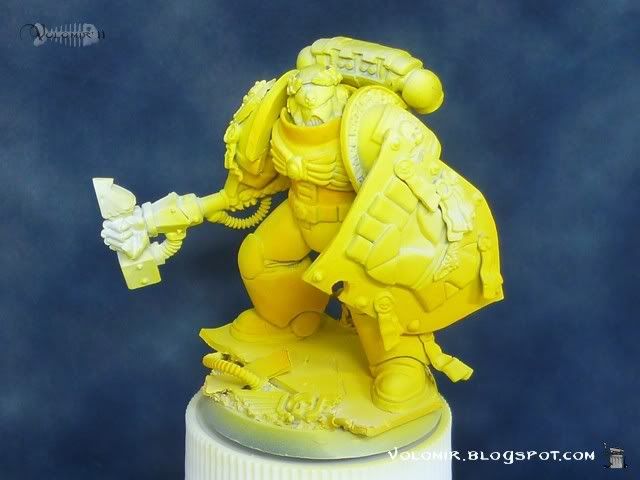
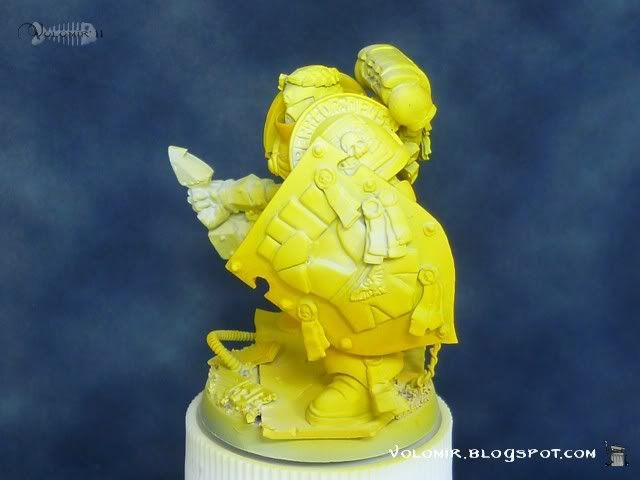

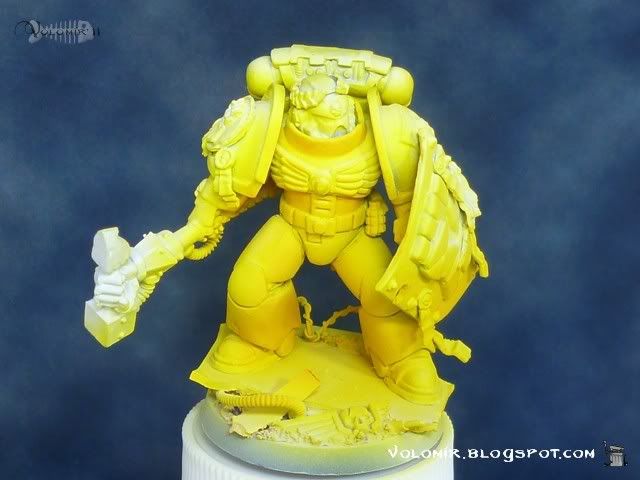
Second shadows with more bestial brown.

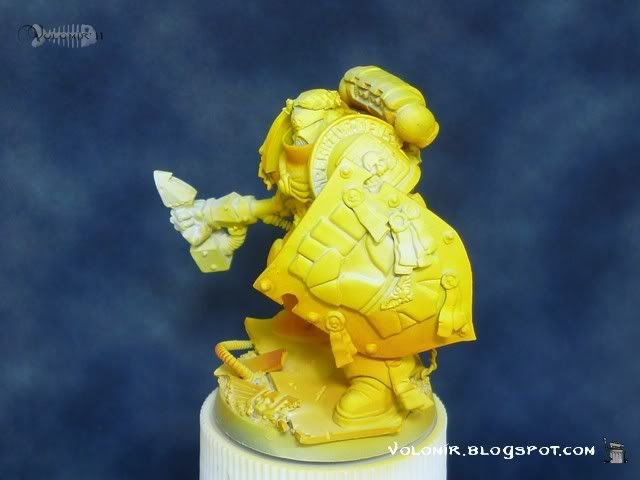
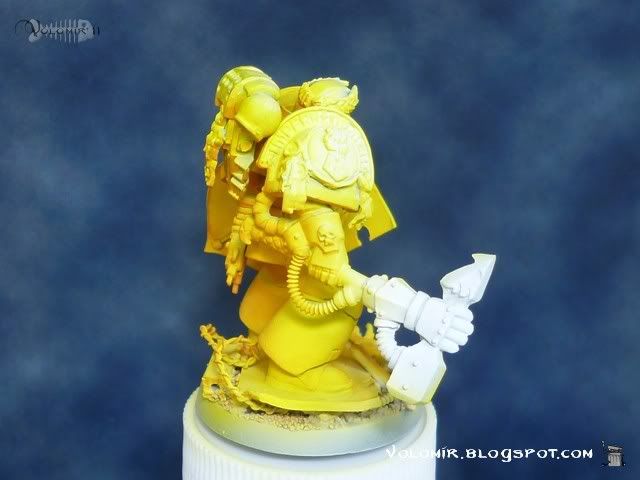
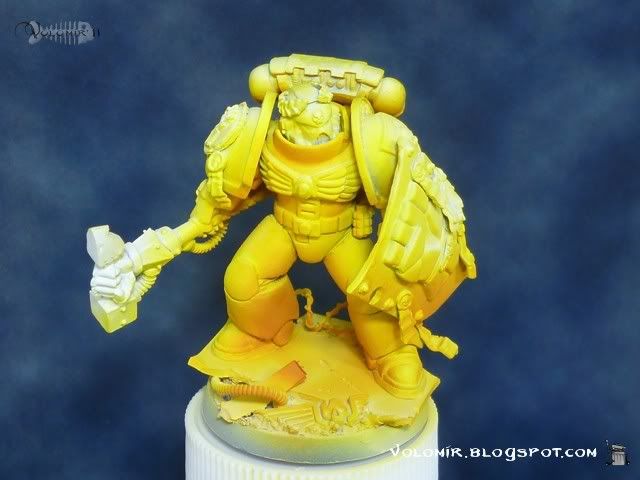
Last shadows with bestial brown adding a little bit of blue, but not too much.
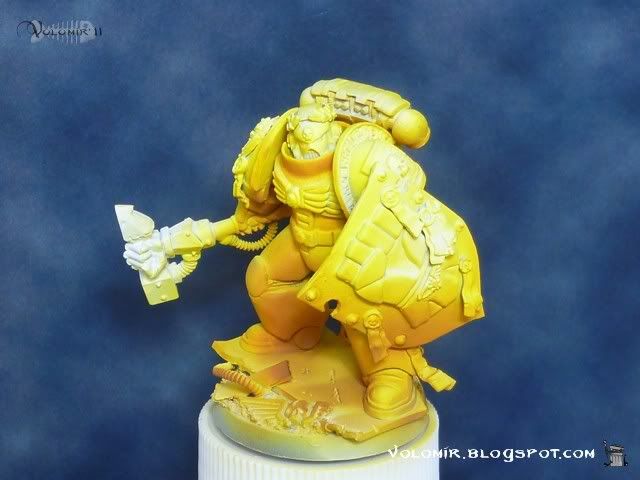
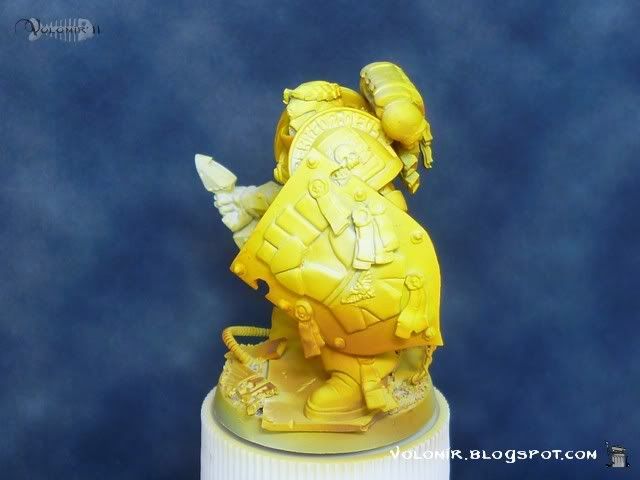
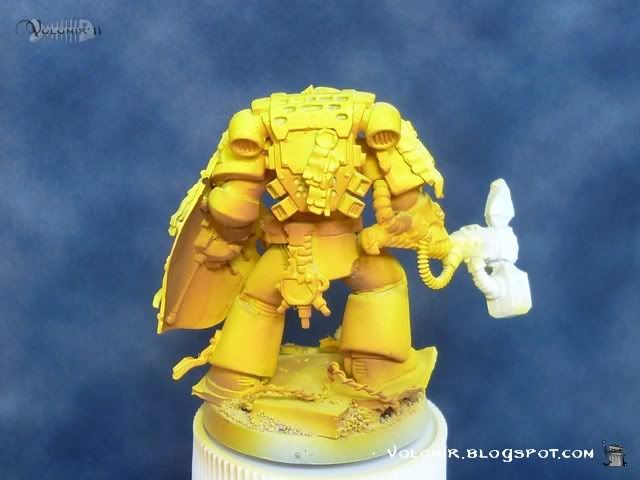
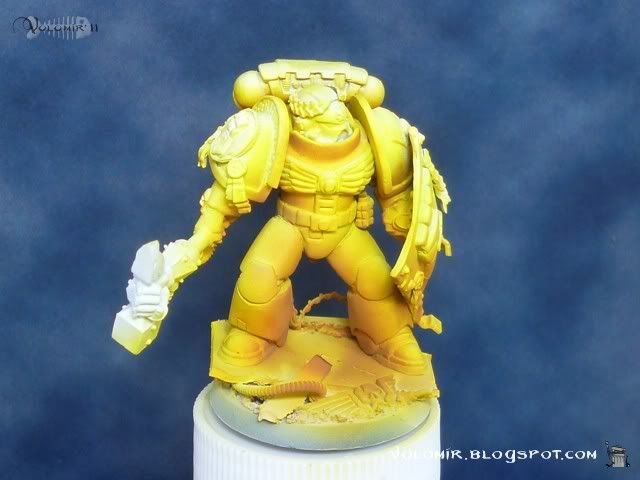
Once I'm satisfied with the overall yellow, I start working on the shield. Even if I am not satisfied entirely with the yellow, I would reccommend passing on to something else, because once the surrounding areas start getting some colour, we will probably see things differently. I want to paint the fist in the shield, in black colours. As it is a big surface, I'll use the airbrush again. So first of all, I'll mask the areas I don't want to paint, with masking tape and also liquid mask for the most difficult parts to mask.

I'll paint the black starting on the lightest colour and then going down progressively to the shadows. Again, this is because I find easier to paint lighter colours over white than over dark colours. So, airbrush in the lightest colour of black, which would be a mid grey to which I'll add a bit of sunburst yellow to ensure coherency with the rest of the miniature.

Adding some black to the mix, next step. This would be our base tone for the black.

Final shadows with pure black. I'll add a bit of blue to certain areas, with the normal brush, so that I add depth to the black.

And now I'll take the masks off.

Leaving the airbrush apart, I'll give black to the parts that will be in that colour. In this step I even give lights and shadows to the blacks in the chest eagle, with the same colour scheme I used in the fist of the shield.



Let's get into the red and white parts. Simon had the head magnetized so I can separate it from the body and paint it separately. So let's use the airbrush to get a very smooth result. I'm going to prime the areas in red and white with just pure white. Then I will mask the white areas and will airbrush in red.
Here's the helmet. It has yellow from the airbrushing of the whole miniature. Let's bring it back to white.


And here's the body. As I said, I mask the areas around the red and whites and prime back to white with airbrush:

And now once I have them white, I'll mask the parts that I want to remain white and airbrush red all over.


First some darker shade of red on the lower parts.


Followed by some classic Blood Red from the top as the lights for red. And this is how it looks after I take the masks off.
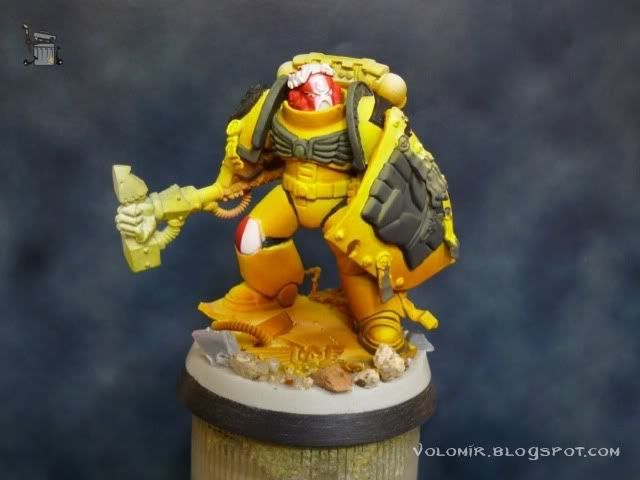
As you see masks are rarely perfect, so I have to give some touches with normal brush to make it cleaner. Here I also start glazing shadows on the kneepad to integrate it with the rest. Another thing to remark here is that I have outlined all the areas in the left leg, interesting thing to see opposing it to the other leg. Really important job to outline, don't you think?

Now some more reds and whites, but using a normal brush. The space now is too little to use the airbrush, and its not worth it.


Without following any planned order, I start basing little elements so I can see better the whole colour composition. So here's me priming the purity seals in their base colours.

In the next step I go back to the airbrush to shadow a little more the right leg on the inside. With the addition of reds, whites, and bases of purity seals, I realized the yellow needed more depth. So I airbrush the inner part of the leg with more bestial brown and black.

But by using the airbrush without too much control, I stepped over the right foot. I want the light back on there, so I'll start that area again, by masking the area around, prime back to white, give a yellow base, and then careful shadows of bestial brown. Seems a lot of colour changing, and indeed it is, but I have practise and the whole operation shouldn't take me more than a couple of minutes.

After that, some more progress to the right leg. Outlining like I did on the other leg, and improving a little the lights on the kneepad and also outlining it.

And this was the final photo I could take of the process. The rest of the work had to be done quite quickly so I couldn't stop to make pictures. Check out the final pics!
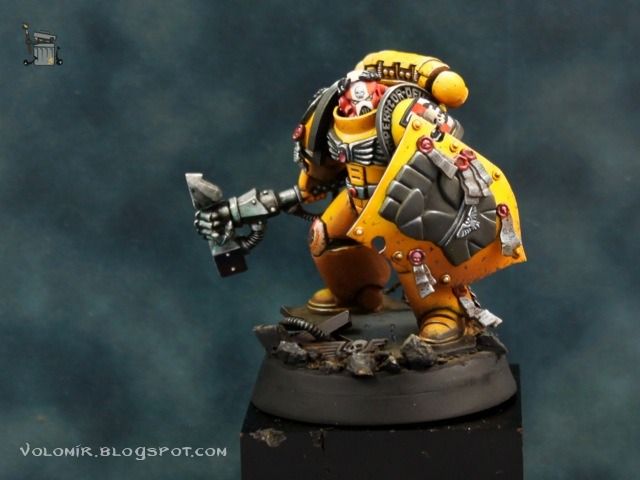

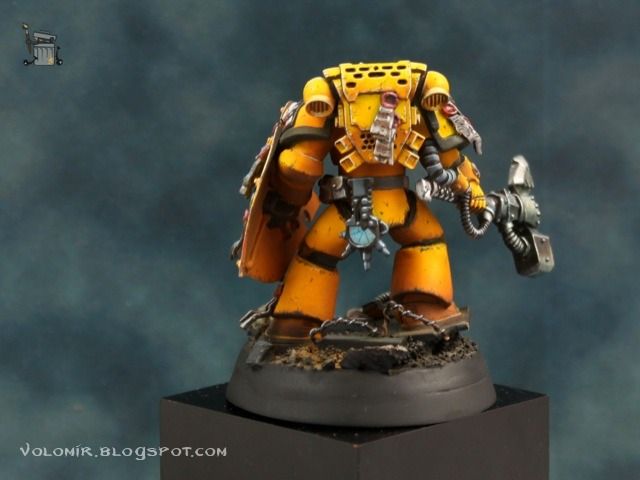
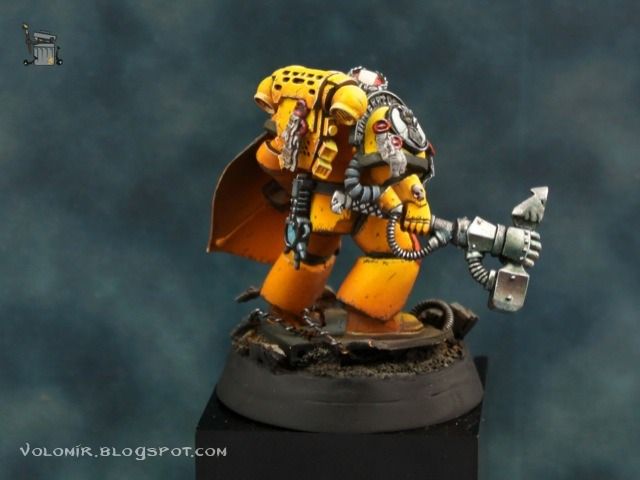


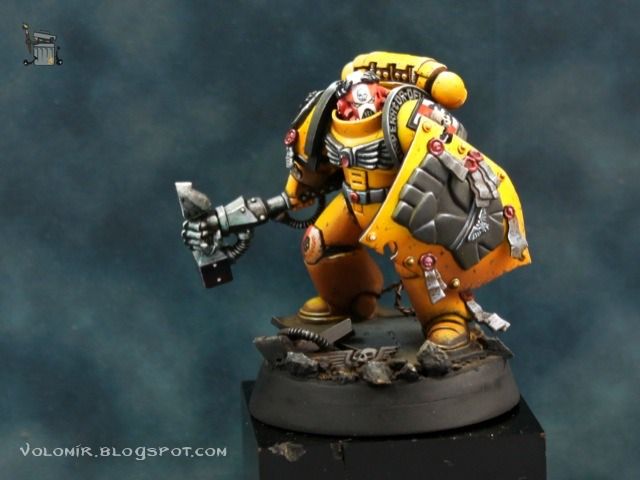

5 comments:
Really nice work (as always)!!
I am curious:
What Airbrush do you use and which nozzle size? What pressure you are working with at that level of detail?
All the best,
-Gewaltatron-
Thanks Gewaltatron!
About the nozzle and pressure, I always use the 0,4 needle and nozzle, and I use the compressor at a 2 bar pressure or so.
Hope it helps!
You, sir, have helped me understand how to achieve the bright color transitions! I really appreciate that. What colors are you using for the different yellow steps? GW, Vallejo?
In this case I basically used GW colours (the old range). I am a big fan of Sunburst yellow! For the lighter yellows I believe I used Ice Yellow from Vallejo.
Glad I could be of help! :)
Amazing work, real shame we couldn't see the entire magic, I'd love to know how you do this level of detail at such small scale, I am just returning to this stuff and looking to hone my skills, but i am all brush and spray paints still, airbrushing is a luxury i sadly cannot afford.
Post a Comment